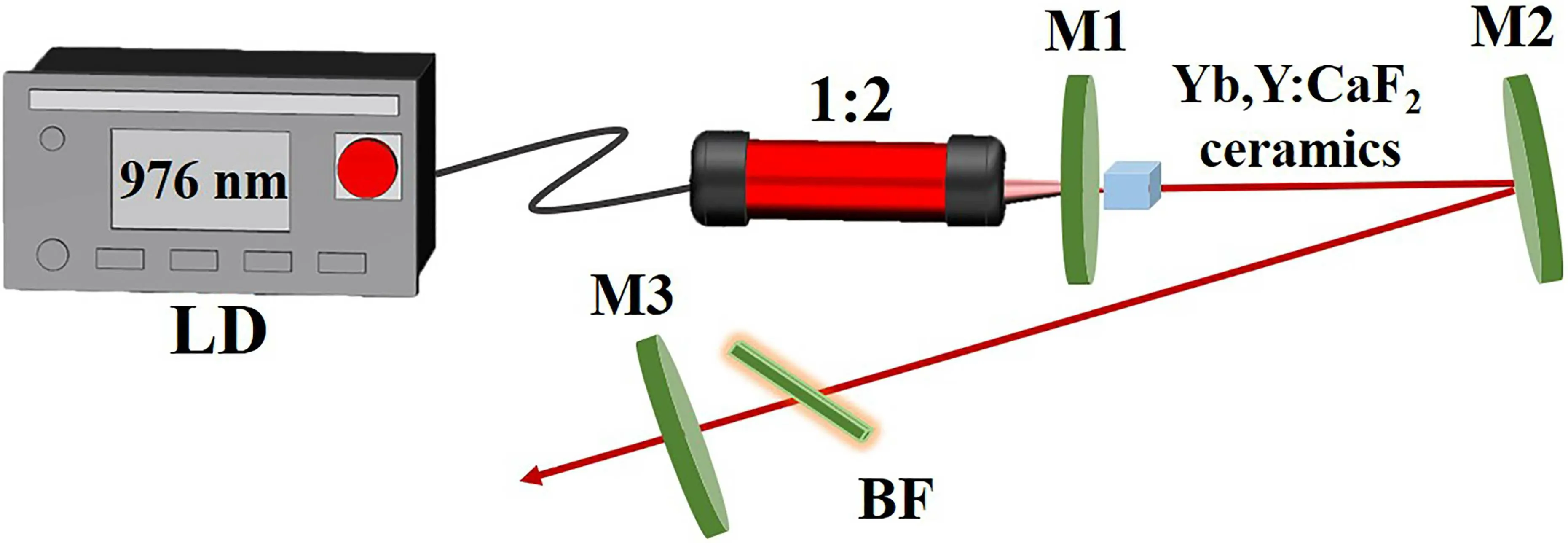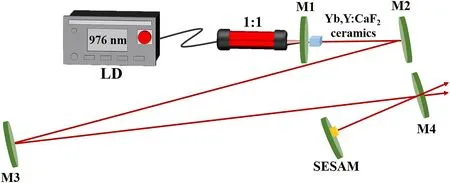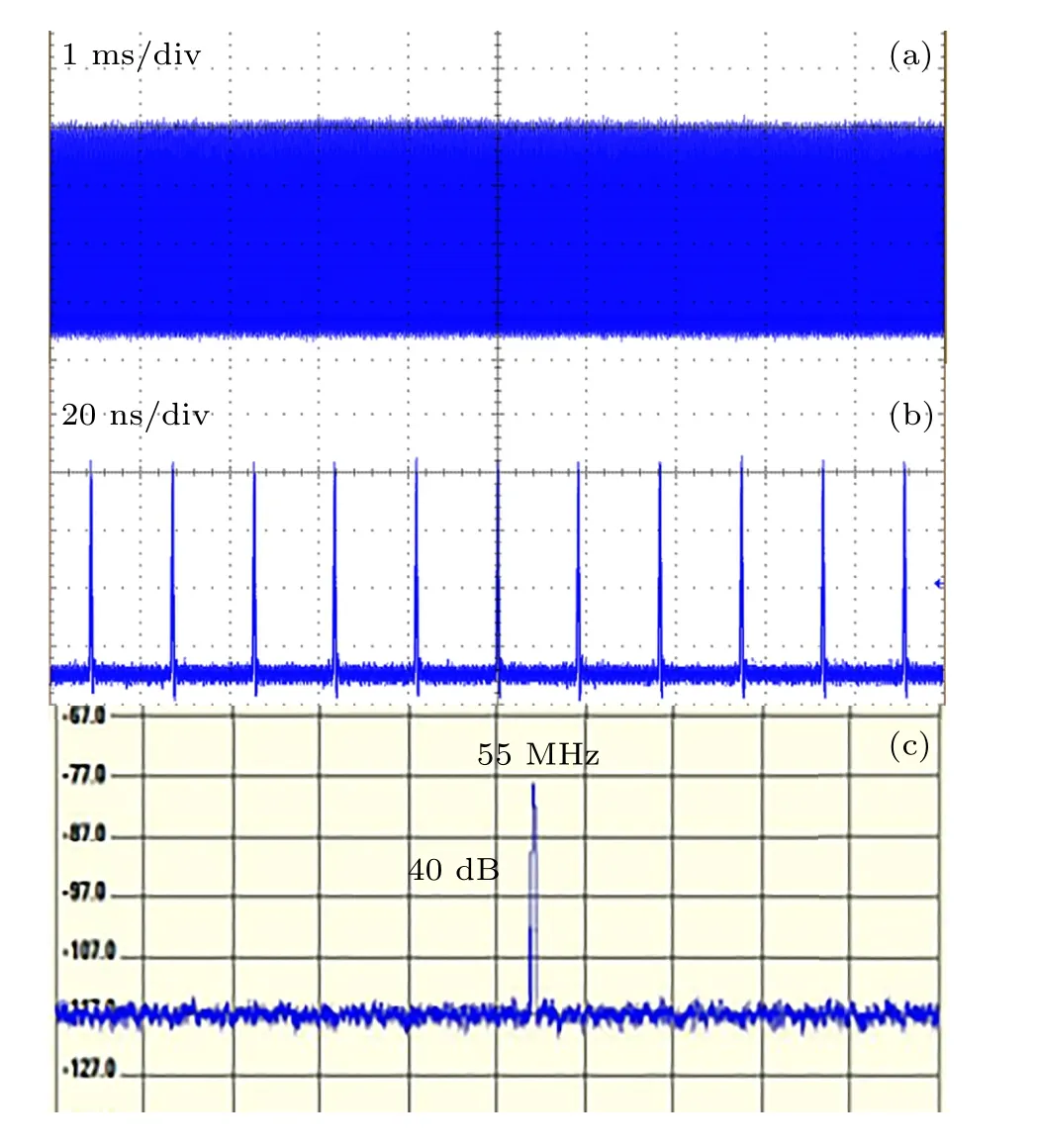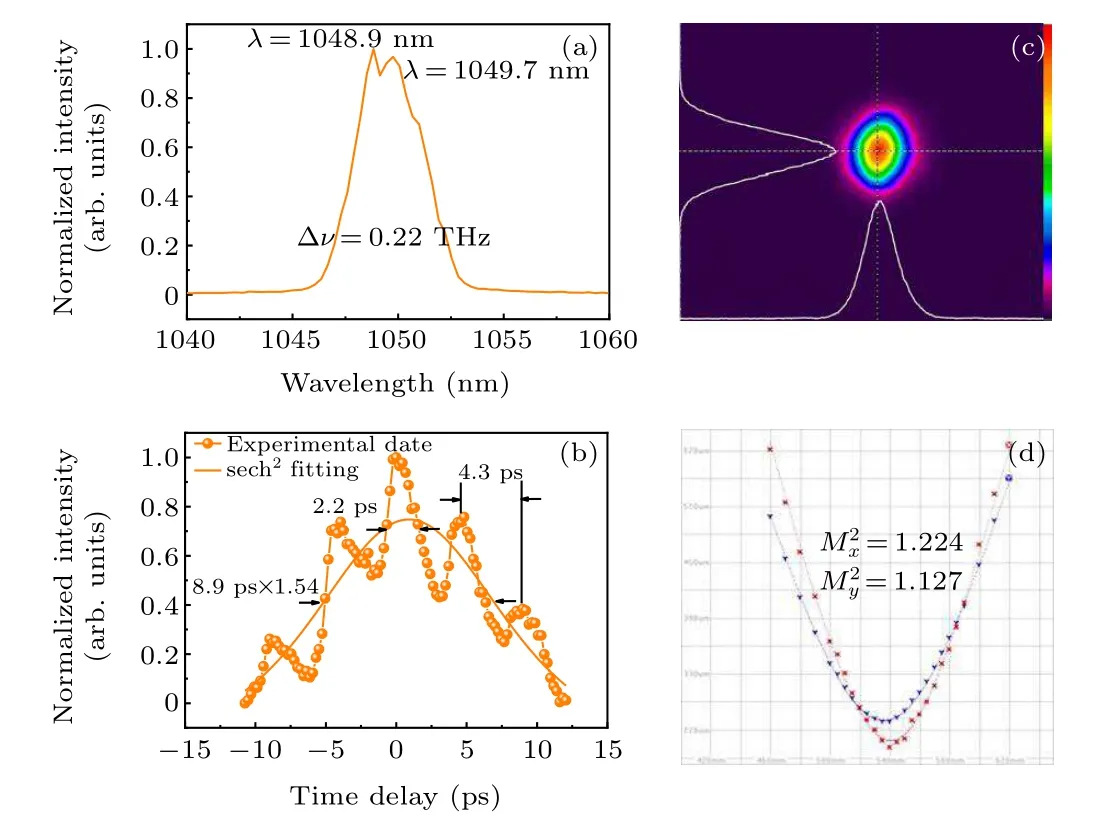Yb:CaF2–YF3 transparent ceramics ultrafast laser at dual gain lines
Xiao-Qin Liu(刘晓琴) Qian-Qian Hao(郝倩倩) Jie Liu(刘杰) Dan-Hua Liu(刘丹华)Wei-Wei Li(李威威) and Liang-Bi Su(苏良碧)
1Shandong Provincial Key Laboratory of Optics and Photonic Device,School of Physics and Electronics,Shandong Normal University,Jinan 250358,China
2State Key Laboratory of Advanced Technology for Materials Synthesis and Processing,Wuhan University of Technology,Wuhan 430070,China
3State Key Laboratory of High Performance Ceramics and Superfine Microstructure,Shanghai Institute of Ceramics,Chinese Academy of Sciences,Shanghai 201899,China
4Center of Materials Science and Optoelectronics Engineering,University of Chinese Academy of Sciences,Beijing 100049,China
Yb3+:CaF2–YF3 transparent ceramics with excellent optical quality was successfully fabricated by hot-pressed method. Pulsed laser properties of this ceramics were investigated for the first time. Laser diode(LD)was applied as the pump source to generate a dual-wavelength mode-locked(ML)laser. The maximum average output power was 310 mW,which represents the highest output power of ultrafast calcium fluoride ceramic laser. The spectrum separated at 1048.9 nm and 1049.7 nm with a total pulse duration of 8.9 ps. The interval period between the beating signals was about 4.3 ps,corresponding to a 0.23 THz beat pulse repetition rate. These results demonstrate its potential in producing dual-wavelength ultrashort pulses.These Yb3+:CaF2–YF3 ceramics with low-cost and short-preparation period are ideal candidate materials for ultrafast lasers.
Keywords: transparent ceramics,passively mode-locking,dual-wavelength laser
1. Introduction
Ultrafast solid-state lasers with narrow pulse width and wide tuning range have an extensive application prospect in many fields such as optical communication, biomedicine and industrial precision processing.Dual-wavelength synchronous mode-locked (ML) lasers have aroused unprecedented research enthusiasm due to their potential applications in terahertz radiation(THz)and ultrahigh beat pulse generation.[1–3]As the core component of solid-state lasers,laser gain medium determines the performance of laser to a great degree.[4–10]Yb3+-doped fluoride materials as a kind of gain medium have attracted significant attention on accounts of their simple electronic structure, broad spectral emission, longer fluorescence lifetime and higher industrialization. Also, the calcium fluoride material is a promising host for Yb3+. Additional advantages of CaF2material include low phonon energy and negative thermo-optical coefficient, and it has broad application prospect in ultrafast laser field.[11,12]The laser properties of Yb:CaF2single crystal have been studied widely.[13–17]Whereas a series of problems existing in single crystal limit the property and widely popularize of fluoride,such as depolarization,low thermo-mechanical resistance and high production cost.[18,19]In addition,polishing of highly doped crystals is still difficult to achieve, which affects the surface quality of crystals and makes them vulnerable to damage. And these problems can only be partially solved by improving the crystal growth process. The appearance of ceramics has become a dramatic and economical choice for improving the characters of calcium fluoride crystal.
The polycrystalline properties and random grain orientation of ceramics make these materials more isotropic and less sensitive to stress and depolarization.[18,20]In addition,ceramics also have the superiorities of natural toughness, flexible and cheap production process, simple manufacturing process and low cost,meanwhile it also can produce complex doping system.[21–27]On account of above advantages, ceramics are expected to be a powerful alternative to crystals, which may rise to the occasion of ultrafast and high-power lasers.[28,29]However,even at low doping concentration,Yb3+ions easily form clusters in CaF2host,which can reduce the luminescence capabilities and quantum efficiency. Introducing buffer ions into CaF2to manipulate the spectral properties can effectively solve this problem. In the years of 2017 and 2021,Kitajimaet al.and Huanget al.fabricated the Yb3+-doped CaF2–LaF3ceramics. They proved that the co-doping of La3+ion can lessen the formation of divalent Yb2+ion,thus improve the efficiency of the laser.[30,31]In 2020,high optical quality of Yb3+:CaF2–YF3ceramics was fabricated by Liet al.It is well known that the grain size of ceramics directly affects its mechanical properties.With the same optical quality,the smaller the grain size,the better the growth quality of ceramics,thus the easier to obtain high power laser. Liet al.used the hot-pressed method and the obtained average grain size was much smaller than the grain size ceramics fabricate by the hot isostatic pressing method. It proves the superiority of the hot-pressed method in preparing Yb3+:CaF2–YF3ceramics. Continuous-wave(CW)laser with high efficiency was achieved. This respect the first laser performance ever obtained with Yb3+:CaF2–YF3ceramics.[32]Whereas, to our knowledge, the study on the pulse characteristics of Yb3+:CaF2–YF3transparent ceramics has not been reported.
Herein,the properties of Yb3+:CaF2–YF3ceramics ultrashort pulsed laser were studied for the first time. A 47-nm tunable laser was achieved. At the state of CWML, a Yb,Ycodoped CaF2ceramics was pumped by a laser diode(LD)to accomplish average output power of 310 mW, corresponding to the two central wavelengths of 1048.9 nm and 1049.7 nm.By observing the beating signals, it can be found that there were a beating frequency of 0.23 THz and full width at halfmaximum(FWHM)duration of 2.2 ps.The oscillator operated under the repetition rate of 54.93 MHz. To our knowledge,this is the first study of Yb3+-doped fluoride ceramics as a gain medium to generate a dual-wavelength synchronous ML solid-state laser. These results suggest that Yb3+:CaF2–YF3ceramics have the ability to generate multi-wavelength ultrafast laser. Subsequently,the generation of coherent THz with high efficiently through the second order nonlinear optical frequency conversion technology is also worthy of expectation.
2. Laser properties of Yb3+:CaF2–YF3 transparent ceramics
The picture of 3 at.% Yb3+, 1 at.% Y3+-codoped CaF2ceramics is shown in Fig. 1(a). As far as we know, the optical transmittance is the most direct means to evaluate the growth quality of samples. Figure 1(b) shows the transmittance curves of the transparent ceramics sintered at 800°C after polishing. As can be seen from Fig.1(b),compared with the optical-graded polishing,the laser-graded polishing significantly improves the transmittance of the ceramics in the short wavelength range. The transmittance around 1100 nm is improved from 90%to 91.7%,while at 400 nm the transmittance is increased from 65.5%to 75%. The slightly lower transmittance in the shortwavelength range means that there are still a few residual pores in the sintered ceramic material, which are one of the main sources of scattering. The optical losses of Yb3+:CaF2–YF3transparent ceramics can be calculated by the following formula:

whereαs(λ) is the scattering coefficient,εis the thickness of the transparent ceramics,T(λ) is the transmittance, andR(λ)is the reflectance of the sample at the considered wavelength. The optical loss of the transparent ceramic is only 2.35×10-2cm-1at 1100 nm,which is very close to the value(1.32×10-2cm-1)in Ref.[18]. The low scattering loss indicates the good optical quality of the obtained ceramics.
The absorption spectrum at room temperature is shown in Fig.1(c),which shows that the ceramics can withstand the thermal drift of the pumping wavelength. Therefore, when using LD direct pumping, there is no need for complex temperature control system,which is more conducive to miniaturization applications. However, it can be seen from Fig. 1(c)that the reabsorption is very serious in the wavelength range of 900 nm–1100 nm, so 896 nm is selected as the excitation wavelength to measure its emission spectrum at room temperature,as shown in Fig.1(d). Yb3+:CaF2–YF3ceramics has a broad fluorescence spectrum,which is favorable for the generation of ultrashort pulsed lasers.
3. Tunable laser of Yb3+:CaF2–YF3 transparent ceramics
The tunable performance was measured by inserting a birefringent filter (BF) into the resonator, as presented in Fig. 2. Considering that the tuning element of the quartz BF has a certain size, a V-shaped folded cavity is designed. Because of the wide absorption spectrum of the ceramics,it can withstand the thermal drift of the pump wavelength, which makes the output laser have better stability. When LD is used as the pump source, complex temperature control system is not required, which facilitates miniaturization. The Yb3+:CaF2–YF3ceramics was pumped by a fiber-coupled LD with a central wavelength of 976 nm, the core diameter of 105 μm and a numerical aperture of 0.22. A 1:2 coupling system can reimage the pump beam in the ceramics. After polishing the two parallel faces, the size of the gain medium was cut to 3 mm×3 mm×3 mm without coating. The temperature of ceramics was maintained at 14°C by water cooling device. The total length of the resonant was designed to be 394 mm. M1 was a flat mirror which was coated with high-transmission (HT) at 980 nm and high-reflection (HR)at 1030 nm–1080 nm. M2 was a concave mirror (radius of curvature is 200 mm),which was coated with HR at 1020 nm–1090 nm. M3 was the flat output coupler(OC)with the transmittance of 2%at 1020 nm–1090 nm.

Fig. 2. The schematic setup of tunability measured on Yb3+:CaF2–YF3 ceramics.
The CW laser was first generated, then after tuning the output power to optimization, BF was inserted between M2 and M3 at Brewster’s angle. By rotating the quartz BF, the output wavelength of the laser can be changed from 1022 nm to 1069 nm, with a wavelength tuning range of 47 nm. The results of the measurements are presented in Fig. 3. As can be seen from the figure,the tuning curve is wide and smooth,indicating that the ceramics has the potential to generate ultrafast laser. Nevertheless,from the emission spectrum of the ceramics (Fig. 1(d)), it can be found that the emission spectrum covers from 960 nm to 1060 nm,the total width is about 100 nm. However, the wavelength tuning range achieved in our laser tuning experiment was only 47 nm. One of the reasons for limiting the wavelength tuning range is that the scope of the cavity mirror coating is too narrow.

Fig.3. Output powers versus emission wavelengths in wavelength tuning regime.
4. Yb3+:CaF2-YF3 transparent ceramics dualwavelength CWML laser
4.1. Experimental setup
By analyzing the fluorescence spectrum and tuning results,the ceramics is favorable for the generation of ultrashort pulses. Therefore, the ultrafast laser characteristics was further studied by using a multi-mirror folded cavity. In order to obtain a dual-wavelength CWML laser,the laser resonator was calculated. As we all know, the output of a dual-wavelength laser must satisfy the following formula:

whereRis the reflectivity of the resonator to a central wavelength,Lis round-trip loss at this wavelength,σis the stimulated emission cross section of transition andηis the quantum efficiency of particle transitions. According to the formula, only the above four physical quantities are related to dual-wavelength synchronous laser. Nevertheless, when the distance between the two central wavelengths is small, the quantum efficiency and loss are almost equal. At this time,it is particularly important to select the appropriate laser cavity mirror.
The schematic of CWML all solid-state laser was designed, shown in Fig. 4. The total length of the folded resonator is 2.73 m. The selection of pump source, the related parameters of ceramics,M1 and M2 are the same as the laser tuning experiment. In order to achieve better cavity modematching condition, a 1 : 1 coupling system reimaged the pump beam in the ceramics. The concave M3 and M4 were both coated with HR film at 1020 nm–1090 nm. M3 has the radius of curvature of-800 mm, and M4 was aT=1%OC with the radius of curvature of-200 mm. The semiconductor saturable absorber mirror (SESAM) was also used as the end mirror of this resonator,which aims to generate and maintain CWML operation. The modulation depth of the SESAM is 1.2%with the relaxation time constant of 1 ps at 1064 nm.By ABCD matrix calculation,the laser mode radius was estimated as 39 μm in the Yb3+:CaF2–YF3ceramics and 45 μm on the SESAM.

Fig.4.Experimental cavity setup of CWML laser with SESAM as modulator element.
4.2. Results and discussion
In the experiment,by fine-tuning the resonator cavity,the laser can be kept in a stable CWML state while maintaining the resonance of two wavelengths. Two synchronous pulses of different carrier frequencies will generate beat frequency signal, so as to realize dual-wavelength synchronous ML laser with beat frequency of THz frequency.At the beginning of the experiment,an all-inverse plane mirror was used as M5 to generate CW laser. After optimizing the CW laser, we changed the plane mirror to SESAM.Adjust the cavity mirrors to produceQ-switched mode-locking (QML) phenomenon. Then continue to slightly regulate the position of SESAM and increase the incident pump power, to keep the laser in a stable CWML state. At this point, the absorbed pump power was in the range of 3.42 W to 6.09 W, while the maximum average output power of CWML was 310 mW. As the incident pump power continued to increase,the CWML pulse sequence begun to become unstable,although the output power continued to increase. Gradually, the QML phenomenon emerged.When reduce the incident pump power to CWML state,a stable ML operation can still be achieved, which indicates that the SESAM was not damaged. Figure 5 shows the relation of average output power with the absorbed pump power.

Fig.5. CWML laser average output power versus absorbed pump power.
The CWML typical pulse trains with different time scales(1 ms/div and 20 ns/div)are presented in Figs.6(a)and 6(b),which were recorded by an oscilloscope (DPO4104, Tektronix) and a fast photodetector whose rise time is less than 175 ps (InGaAs ET-3000). The smooth contour of the pulse trains indicates that the CWML operated in a stable state.From Fig. 6(b), the laser remained as TEM00with a repetition rate of 54.93 MHz. Measured value is almost equal to the theoretical value,which is calculated by
From the pulse trains of the oscilloscope,it can be seen that the CWML laser pulse trains of the two wavelengths coincide in space.To further observe the stability of CWML operation,we used a spectrum analyzer(Rohde&Schwarz FSC 3)to track the radio frequency (RF) characteristics shown in Fig. 6(c).A sharp peak located at 55 MHz was observed, which was well matched with the above repetition rate. The signal-tonoise ratio reached about 40 dB and no side peaks appeared,indicating that the laser worked stably. Meanwhile,when using the SESAM as a mode-locker,the sable CWML operation could be maintained for several hours in laboratory environment. And as long as the pump power was added to the corresponding mode-locking threshold, the stable mode-locking could start automatically.

Fig.6. (a)and(b)The CWML pulse trains recorded at different time scales,(c)recorded radio frequency spectrum of CWML laser.
The central wavelengths of dual-wavelength synchronous CWML laser were 1048.9 nm and 1049.7 nm, which were measured by a spectrometer (Ava-spec 3648-USB2), as present in Fig. 7(a). Through calculation, we can get that the central wavelength frequency difference of the spectrum as 0.22 THz. The envelope spectrum had a FWHM of 3.8 nm.Whereas, it is difficult to simulate the FWHM of the two peaks because of the small peaks buried in the envelope. As the measurement accuracy of the spectrometer is 0.5 nm, the two laser wavelengths cannot be separated obviously. A commercial intensity autocorrelator(Femtochrome Research,Inc.FR-103XL) was used to measure the autocorrelation trace of this ceramics synchronous CWML pulse and verified the dualwavelength laser operation, illustrated in Fig.7(b). The optical beating between the two carrier-wave frequencies of the dual-wavelength CWML pulses can be clearly observed from Fig. 7(b), indicating that the dual-wavelength CWML pulses were temporally synchronous. The pulse duration was fitted to 8.9 ps using a sech2pulse function.The FWHM duration of the beating signal was found to be 2.2 ps. The interval period between the beating signals was about 4.3 ps, which correspond to a repetition rate of 0.23 THz. In our case, this repetition rate exactly equals to the frequency difference of dual wavelengths at 1048.9 nm and 1049.7 nm. The chirp exists in the resonator, we will further compress the pulse width with dispersion compensation technology to achieve femtosecond ultrashort pulse lasers. Using a laser beam quality analyzer(Spiricon-M2-200S-USB), we characterized the output beam quality and the spatial beam profile of the dual-wavelength CWML laser, shown in Figs. 7(c) and 7(d). TheM2factors ofM2xandM2ywere 1.224 and 1.127, respectively. The symmetric hyperbolic function forecast the CWML laser operated in near Gaussian mode. Subsequent combination of frequency conversion techniques(such as difference frequency,sum frequency and double frequency)is expected to broaden the laser wavelength range, which is an important application of dualwavelength lasers.

Fig.7. (a)and(b)Measured laser spectrum,the corresponding autocorrelation trace and fitting plot;(c)and(d)laser beam profile and M2 factor.
5. Conclusion and perspectives
To sum up,the pulse laser properties of Yb3+:CaF2–YF3ceramics were demonstrated for the first time. A smoothing and wide-band wavelength tunability is verified. The maximum output power center is 1046.7 nm and the wavelength tuning range is 47 nm. These results signify the potential of this ceramics in the ultrafast field. By using SESAM as saturable absorber, an autocorrelation pattern of a dualwavelength synchronously CWML laser was achieved. The central wavelengths were located at 1048.9 nm and 1049.7 nm with 4.3 ps separated duration. The beat pulse repetition rate was 0.23 THz, which was matching well with the frequency difference of dual wavelengths at 1048.9 nm and 1049.7 nm.The duration of one beat pulse was approximately 2.2 ps which was recorded assuming the sech2fitting pulse shape.The maximum average output power was 310 mW, which represents the highest output power of ultrafast calcium fluoride ceramic solid-state lasers. Combined with the simple and budget synthesis system,it opens a new route for femtosecond ultrashort pulse lasers.
Acknowledgments
Project supported by the National Natural Science Foundation of China (Grant Nos. 11974220 and 51902234) and the Natural Science Foundation of Shandong Province,China(Grant No.ZR2021LLZ008).
- Chinese Physics B的其它文章
- A design of resonant cavity with an improved coupling-adjusting mechanism for the W-band EPR spectrometer
- Photoreflectance system based on vacuum ultraviolet laser at 177.3 nm
- Topological photonic states in gyromagnetic photonic crystals:Physics,properties,and applications
- Structure of continuous matrix product operator for transverse field Ising model: An analytic and numerical study
- Riemann–Hilbert approach and N double-pole solutions for a nonlinear Schr¨odinger-type equation
- Diffusion dynamics in branched spherical structure

